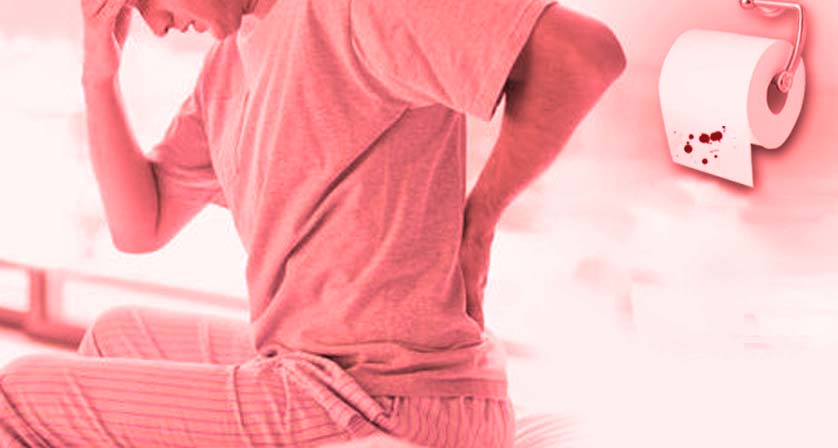Ayurvedic Management of Piles

Piles are swollen veins of the anal passage. When a person passes hard stools or exerts lot of pressure due to constipation, the veins in anal canal get stretched and bruised to swell and become painful. These swollen veins are named as hemorrhoids or piles.
Types of Piles
According to site
1. Internal: Found inside the anus or lower rectum. These are usually not painful but bleed when they are irritated such as during the passage of hard stool.
2. External: Found on the tissues surrounding anal sphincter. These are present as a swelling outside the anus and create itching and irritation. These can be painful some times. These usually do not bleed.
3. Interoexternal: Both the above types together occur.
According to position
1. Primary Piles: Located at 3, 7, 11o’clock positions, related to the branches of the superior hemorrhoidal vessel which divides on the right side in to two, left side it continues as one.
2. Secondary Piles: one which occur between the primary sites.
According to Degree
1. First degree: Piles within anus that may bleed but do not come out .
2. Second degree: Piles that prolapse during defecation but return back spontaneously.
3. Third degree: Piles prolapsed during defecation, can be replaced back only by manual help.
4. Fourth degree: Piles that are permanently prolapsed.
Piles can be mucosal or vascular. Vascular type is seen in young whereas mucosal is seen in old.
Factors Responsible for Piles
1 Hereditary Some people may inherit a weakness of the walls of veins in the anal region.
2 Morphological: Weight in the valveless blood column causes high pressure in anal canal and results in congestion.
3. Straining
4. Diarrhoea
5. Constipation
6. Low fibre diet
7. Over purgation
8. Sitting over the toilet for long time
9. Carcinoma rectum
10. Pregnancy: Raised progesterone level (relaxing the venous wall and reduces its tone) and compression due to enlarged uterus.
11. Increased intra abdominal pressure eg. pregnancy, ascites.
CLINICAL FEATURES
1. Age Mostly seen in the age between 30-65years.
2. Incidence Equal in both the sexes.
3. Bleeding The first symptom –‘splash in the pan’. Bright red and fresh rectal bleeding occurs during defecation.
4. Itching around anus.
5. Mass per anum.
6. Discharge A mucoid discharge which may irritate the skin around anus.
7. Pain May be due to prolapse, infection or spasm. Internal hemorrhoids are usually painless until or unless they are thrombosed. External hemorrhoids often result in pain and swelling in the area of anus.
8. Discomfort When passing stools or afterwards.
9. Sense of fullness in anus.
On examination, prolapsed piles will be visualized. On digital examination, only thrombosed piles can be felt.
TREATMENT
Preventive
1. More fibre diet
Increase the intake of whole wheat flour, whole grains, brown rice, barley, legumes, green leafy vegetables.
2. Liquids
Increase daily liquid consumption in the form of water, soup, milk, butter milk, juice etc.
3. Laxatives
Isabgol husk, Berries, Figs, Apples, Prunes, Pears.
Avoid Tea, coffee, aerated drinks, alcoholic beverages, refined oils, packaged and canned foods. Avoid straining on the toilet.
Conservative Treatment With Ayurvedic Herbs
1. Haritaki
One of the most effective ayurvedic medicine for piles which can resolve the problem easily. It keeps stool soft, promotes smooth and complete defecation, improves digestion and increases enzymatic activities.
2.Rasaunt
A very beneficial ayurvedic medicine for piles. It improves digestion, causes regular defecation and more importantly treats and heals ruptured vessels and cuts in anal passage.
3. Nagkesar
It stops bleeding, supplements antioxidants and is anti-inflammatory.
4. Erand (Castor oil plant)
Drinking a small teaspoon of castor oil mixed with milk will help soften the stool and reduce the pressure on rectal walls.
5. Bahera
It is anti inflammatory in nature and has anti bacterial action. It fights against infection occurring in piles. Due to its laxative property, it is also useful in constipation.
6. Amlaki
It is believed to possess the highest concentration of vitamin C as well as many medicinal properties. It is used as laxative to relieve constipation in piles. It has anti bacterial and astringent properties that help prevent infection and help in the healing of ulcers.
7. Jimikand
Also known as enemy of piles. It has property of digestion, purging and gives feeling of lightness. It is high in fiber content and therefore gives relief in constipation.
8. Ghrit kumari
It is made up of 1% glycoproteins and polysacchrides and 90% water. It helps to reduce pain and promotes repair. It has properties to activate the immune system of body so it can fight off the infections around the anus and rectum. The natural astringent properties of aloe vera reduce the size of pile mass.
9. Butter milk
There is no medicine better than butter milk for the care of piles. It is said in ayurveda, piles in anus once cured by administration of butter milk don’t recur.
10. Sitz bath
Sit in warm water or warm medicated decoctions to help relieve the pain in anal region.
Commonly Used Ayurvedic Formulations for Piles
• Abhyarishta
• Phalarishta
• Pippalyadya ghrit
• Triyushanadi churna
• Chitrakadi vati
• Rasanjan vati
• Triphala churna
• Panchaskar churna
• Local application of medicated oils like Kasisadi tail, Jatyadi tail.
Parasurgical Measures to treat Piles
Kshar application & Kshar Sutra Therapy
A very good non surgical treatment termed ‘kshar lepa’ (alkaline application) or kshar sutra (alkaline seton) for the cure of piles with minimal recurrence.
The kshara is applied in the form of a paste over the pile masses or the kshara sutra is tied to the base of pile mass by ayurvedic surgeon. This cauterizes the pile mass, coagulates and breaks down the collected blood in the veins and thus gradually eliminates pile mass.
Surgical
Surgery is reserved for those who fail to improve with the above measures.